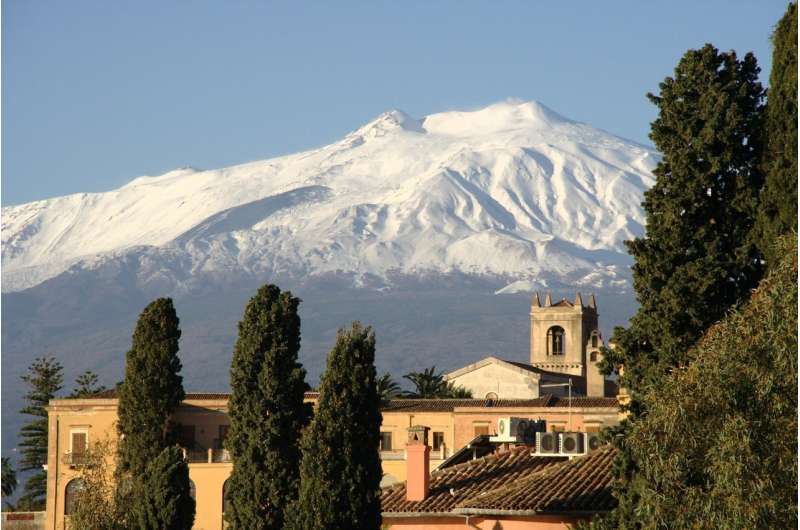January 17, 2018 report
Volcanologist suggests Mt. Etna behaves more like a giant hot spring than a volcano

Carmelo Ferlito, a volcanologist at Università di Catania, in Sicily, has suggested in a paper published in the journal Earth-Science Reviews that Mt. Etna behaves more like a giant hot spring than a volcano. He is not, as some publications have suggested, claiming to have found evidence showing that Mt. Etna is not a volcano, but suggests that it has some properties that are different than other volcanoes.
Mt. Etna is a volcano situated on the northeastern side of the island of Sicily, which is just off the toe of the boot of Italy. It is the tallest volcano in Europe, and is famous because it is so active. In addition to spewing tons of lava, it also emits an enormous amount of steam, sulphur dioxide and carbon dioxide. It is these other emissions that has Ferlito convinced that there is something different going on with the volcano.
Ferlito notes that most theories surrounding volcanos suggest that steam, carbon dioxide, sulphur dioxide and other gases that are trapped in magma are released into the air as the magma cools after being ejected from the volcano. But, he notes, no one has been able to explain how so much of the gas can be released from Etna's proportionally small amount of magma release. He points out that for Etna to produce as much water and gas as it does, it would need to produce 10 times as much lava. This, he further suggests, is because not all of the steam and gases spewed into the air by Etna are released from magma—instead, they reside in underground pockets and pools, and are forced to the surface when they become hot.
Ferlito also points out a problem with another theory that suggests steam and gases might be released from magma inside the volcano before it can be expelled, causing the magma to fall back into the volcano. He notes that if this were the case, the volcano would inflate like a balloon.
He believes that the source of the steam is water pockets beneath or near the volcano, which are turned to steam and rise to the surface and are released—as happens with hot springs. He cites recent research by others indicating that there may be much more water in the mantle than has been thought.
More information: Carmelo Ferlito. Mount Etna volcano (Italy). Just a giant hot spring!, Earth-Science Reviews (2017). DOI: 10.1016/j.earscirev.2017.10.004
Abstract
It is usually believed that volcanoes explicate their activity erupting magma, in which volatiles (mostly H2O) are dissolved in modest quantities. At Mount Etna, the maximum H2O found in olivine melt inclusions is 3.5 wt%, which would correspond to a moles H2O/mol basalt ratio of 0.14. A reappraisal of published data is proposed here, and a comparison is made between the gas flux and the volume of erupted lavas. The results are surprising: the moles H2O/mol basalt ratio is 1.41, which means that Mount Etna erupts 10 times the maximum H2O that could be dissolved in magma and 40% more moles of gas (H2O, CO2 and S) than moles of basalt. By calculating the molar volume of the basaltic melt components (silicate tetrahedra and metallic cations) and of the gas phase at a pressure of 250 MPa, it is possible to envisage the magma within the deep plumbing system as a solution made of ~ 70% continuum gas phase (mostly H2O) at a supercritical state (density 360 kg/m3) and 30% basaltic melt components. The transition from this low-density (1140 kg/m3) water melt solution (WMS) to the high-density (2800 kg/m3) basalt, usually erupted (defined as a continuous melt phase, CMP), occurs in the last 2 km and marks the boundary between a deep and a shallow plumbing system. The depth of this boundary varies with time, being driven by the rate at which the gas escapes the WMS to feed the persistent gas plume at the summit craters, leaving the CMP, which accumulates within the shallow plumbing system, until erupted. The overpressure of the gas phase in the WMS, acting like a piston cylinder, is fundamental in driving the eruption. In this work, the thermal contribution provided to the CMP by the large gas flux has also been considered, proving that it can supply the heat necessary to maintain the CMP. The volcano is here considered a dynamic system in which the eruptive activity is ruled by discontinuities in the flux of gas and heat. Negative fluctuations in the gas flux would decrease the heat supply, promote viscosity and trigger eruptions. Moreover, this view of the volcanic system, subverting the common paradigm in which the gas emitted is associated with an equivalent amount of degassing magma, explains the phenomenon, known as the 'excess degassing problem', which affects volcanoes of basaltic and andesitic nature worldwide.
© 2018 Phys.org



















